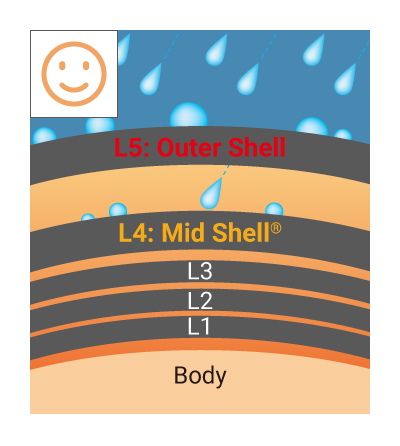The rush of wind and the crisp mountain air - the mountains, with their majestic peaks and pristine blankets of snow, call out to adventurers seeking the thrill of gliding down the powder. But conquering the slopes requires more than just skill on skis - you also need a strategic approach to dressing for the elements. Here’s where the art of layering comes in, transforming a simple winter wardrobe into a shield against biting winds and sub-zero temperature.
More than helping you stay warm; layering keeps you dry, comfortable, and ready to embrace the challenges of winter alpine conditions. Building on the traditional 3-layer strategy, Finetrack has developed their innovative 5 LAYERING® system, where Finetrack's synergistic technology makes the whole greater than the sum of its parts.

In this comprehensive guide, we will explore the basics of layering men's ski clothes, providing a straightforward approach to staying warm and comfortable on snow-covered terrain based on Finetrack’s 5 LAYERING® system.
1. The Foundation: Base Layer
The foundation of any effective layering system is the base layer. The goal is to trap heat close to your body while efficiently managing moisture. Whether it's sweat generated during physical activity or moisture from external sources, the base layer helps move it away from your body, keeping you dry.
Finetrack's base layers use a hybrid of natural fibers for superior comfort and synthetic fibers with high functionality to efficiently transmit moisture away and keep you dry and warm. Using a two-layered tubular stitched fabric to retain warm air between layers, the Merino Spin Thermo series is a great option that provides superior heat retention for the cold temperatures on the slopes.
2. Building Warmth: Mid Layer
The mid layer is your insulation against the biting cold. Its design focuses on maintaining warmth without adding excessive bulk, ensuring comfort and mobility. This layer, often made of materials like fleece, down, or synthetic fabrics, provides insulation by creating loft and trapping a layer of air within the garment. Each of these materials have different pros and cons. Fleece provides good insulation but tends to be bulky with minimal moisture-wicking ability, whereas down has great insulating abilities while being lightweight but loses its function once it absorbs moisture. This makes it hard for down to be used as active insulation.
To balance both warmth and breathability, Finetrack developed a unique synthetic material called FINEPOLYGON, the world’s first sheet-type, three-dimensional, breathable insulation material. FINEPOLYGON is a notable advancement in mid layer technology as it does not retain perspiration moisture absorbed by the lining, and retains its loft even when wet. This means you can continue wearing your insulation during uphill hikes or other exertions that tend to create heat and sweat.
Finetrack offers both insulated and non-insulated mid layers, for a range of weather conditions, that also come equipped with the LINKVENT® feature. The Finetrack LINKVENT® system is designed so that the ventilation zippers on mid to outer layers are placed in the same, easily accessible position. This allows the different layers to work together to control temperature and humidity more efficiently.

3. Facing the Elements: Mid Shell® and Outer Shell
Designed to shield you against wind, snow and rain, the outer layer is your first line of defense against the elements. There are two types of outer layers, the hard shell and the soft shell. Soft shell jackets offer a balance of breathability, flexibility, and water resistance, making them ideal for more dynamic activities such as hiking and climbing in moderate conditions. Hard shells, crafted from waterproof and windproof materials, excel in extreme weather, providing optimal protection against rain and snow, making them a great choice for skiing.
For enhanced flexibility and adaptability, Finetrack developed the Double Shell® system, which uses two layers of shells, the Outer Shell, and their Mid Shell® layer. This two-layer approach ensures wetness does not have the chance to break through and, at the same time, provides better heat retention than a single shell approach.

When used together, the two shells also create an effect similar to the double pane window system used in cold climates, preventing condensation from forming inside the layering system while the trapped air between the two layers provides a layer insulation. Best of all, the advanced breathability and flexibility of this system, along with the LINKVENT features, means that you do not have to add or remove layers as conditions change as the system retains heat effectively and the ventilation features allow you to release excess heat if needed.
4. Hands and Feet Essentials
When preparing your layering strategy, don’t forget your extremities. Proper gear for your hands and feet go a long way in offering warmth, comfort and protection in the cold. For your hands, start with a thin, moisture-wicking inner glove to keep your hands dry and maintain dexterity. Finetrack’s Merino Spin Gloves are an excellent option that provides warmth and a snug, ‘bare hand fit’. For skiing, this can be paired with a waterproof outer glove.
Your feet can also produce quite a bit of sweat when active, and also face the chance of water penetration from the outside. To keep your feet dry and warm, opt for high-performance ski socks and consider socks layering, which can make a big difference in your overall comfort.
5. Innerwear: The Game-Changing Elemental Layer®
Out on the slopes, staying comfortable makes a big difference on the experience you have. Experienced skiers know that one of the most important elements to ensuring your comfort is staying dry. Especially after a long and hard approach, sweat that accumulates on your skin during your climb can quickly cool and cause back chills when you are at rest.
Your base layer takes on this challenge by absorbing and diffusing away the sweat from your skin. However, even the best base layer takes some time to dry. In the meantime, your skin remains in contact with the wet base layer, causing you to lose valuable body heat as it dries. To tackle this problem, Finetrack developed the game-changing Elemental Layer®.

Designed to work in perfect synergy with your base layer, the Elemental Layer® is a thin, next-to-skin, fine mesh and water-repellent layer worn beneath the usual moisture-wicking, quick-drying base layer. The fine mesh material is designed to allow moisture through to the quick-drying base layer, where it will be diffused away. The Elemental Layer® then works as a shield that protects the skin from touching the wet base layer while it dries, keeping you comfortably dry and preventing unnecessary heat loss from back chills.
The concept of using the water-repellent Elemental Layer next to your skin also works well for protecting your extremities. Worn as the first layer on your hands and feet, the Elemental Layer prevents your fingers and toes from being in contact with wet gloves and socks, preventing frostbite and further ensuring your comfort.
Finetrack’s Elemental Layer series includes shirts and tights as well as sock and glove liners. Altogether, these layers provide complete comfort on your ski adventures by keeping you dry from start to finish.
The unique and dynamic nature of skiing demands adaptability to changing weather conditions and varying levels of physical exertion. Mastering the art of layering men's ski clothes is a fundamental skill that goes beyond basic functions - it is a key element in ensuring comfort, safety, and optimal performance on the slopes. Effective layering allows you to regulate your body temperature, manage moisture, and protect yourself from the elements while out on the slopes, and Finetrack’s 5 LAYERING system provides the best in layering innovation through its versatile and efficient layers - designed by outdoor enthusiasts, for outdoor enthusiasts.
Gear up, embrace the cold, and let Finetrack’s layers keep you warm on your next skiing adventure!
